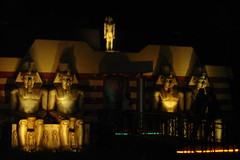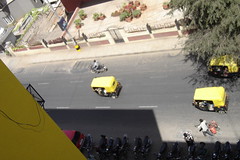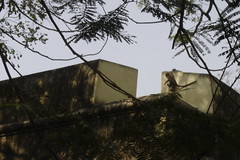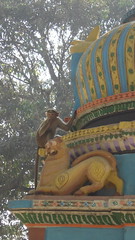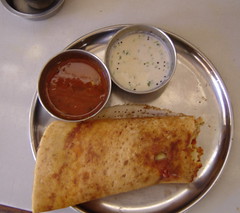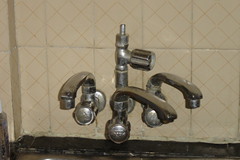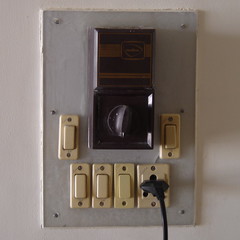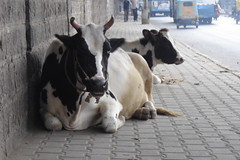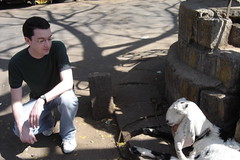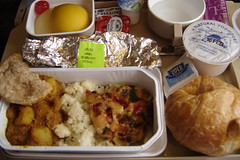Two New Yorkers spend six months 18 months!?! in Bangalore and other places in India.
Tuesday, February 28, 2006
Indian Food at Jaunted
Any suggestions for next week and beyond?
Monday, February 27, 2006
Thursday, February 23, 2006
A Night at the Hookah
Outside the grand entrance to the club, a large sign said "positively no stags," but since our friend Ray knew the doorman, we all got in. Admission was steep, at 400 rupees, but it was good against food and drink. Inside, the Egyptian theme was in full force, with a big sarcaphogus-head for a DJ booth and hookahs.
After a bit, the doorman came up to me and asked me not to take any pictures inside, since he'd seen my camera. Having dancing going on is not exactly encouraged in this area, and it's kind of amazing that there is one at all. Being away from the main drag may have helped.
The small-but-impressive dance floor was packed with what Don said may very well have been the coolest kids for 100 miles around. The music was pretty good -- a mix of hip hop, bhangra, some older alternative music, and, of course, Bryan Adams, who is very big in India (he played Bangalore and Mumbai a couple weeks ago). We were some of the smattering of whites there, but there were also a half-dozen of so black people -- surprising, since I've seen maybe four in my three weeks in Bangalore. I couldn't think of any polite way to ask, but I was wondering where they were from. Ray talked with one of them and solved the mystery. Despite the Yankee caps and athletic gear they were wearing, they were South African college students studying in the area. From the sounds of it, they were a little homesick.
We'd gotten there around 10:15 or so, so it was already approaching the bar's closing time. In Mysore (as in Bangalore), it's at the no-so-wild hour of 11:30. Don and I decided that we had better get another drink to try to recoup some more of that 400 rupees. We ordered two brandies -- it seemed like a good idea at the time. The bartender, who looked as if he was about 16, said what we thought meant that they had no brandy, or maybe just not the brands on the extensive drinks and food menu. First Don and then I gave him our respective tickets anyway, since it wasn't clear what the deal was. I asked for brandy a few more times, for good measure, and the bartender looked at me a little strangely. We weren't exactly heartbroken, but it was a letdown that we'd handed over our soon-to-be-worthless tickets over nonexistent brandy.
At just about 11:30 on the dot, two heaping plates of rice appeared, with forks sticking out of them. Brandy, biryani (the rice dish they'd made), it probably does sound pretty much the same when a remix of "Summer of '69" is blasting in the background and the menu contains so many possibilities.
We all laughed, we couldn't help it, but mostly I felt bad that someone had spent the time cooking up dishes that we definitely couldn't eat at that point. We did manage to get all that rice wrapped to go. Since we were leaving tomorrow, we gave the heavy containers to the rickshaw driver when he dropped us off at the hotel, so hopefully all that biryani didn't go to waste. And that was our big night out in Mysore.
Wednesday, February 22, 2006
Autorickshaws Rule Our Lives
The autorickshaw driver sits in front and drives an engine that's about as powerful as a scooter. The back passenger bench holds about three people in a pinch, or two of them with packages. (If you're talking about little kids, then rickshaw capacity is much, much higher.) Everything's covered over with a bright yellow vinyl cab.
All the rickshaws have meters that are supposed to be used for every trip. Here in Bangalore, the first kilometer costs 10 rupees, and after that it goes up by half-rupees in little clicks. About 75% of the time, the driver refuses to turn on the meter and will want you to pay a set amount to take you to your destination. This amount, of course, is higher than the metered rate would be, with a hefty tip thrown in. The willingness to bargain over the fee and come to an agreement depends on how willing you are to bail and to wait for another rickshaw to come putt-putting down the road. One of our more idealistic guidebooks claims that all locals insist on using meters, and so should tourists. I'm pretty sure that plenty of locals are also paying set fees, albeit ones that are less than mine. Anyway, the point is you can't always get the guy to turn on the meter.
If the meter's off, we always haggle over the price, although that's usually only good for a reduction of 10 rupees. A surprising amount of time, rickshaw drivers don't want to bargain, and we have to wait for another. That's OK, there often seems to be about one rickshaw for everyone in town. (If you later catch your driver bragging to another driver when they're stopped at a light about how much he's charging for the ride, then you didn't bargain hard enough. Not that something so embarrassing ever happened to us . . . .)
If you're going to haggle, it helps to be sure that the driver and you both have the same destination in mind. Street names are not always useful, probably because we often mangle the pronouciation. Landmarks are better, but it can sometimes be hard to know what qualifies as a landmark. Rickshaw-worthy landmarks are not necessarily the same things that maps or tourists think are important. Saying that we want to go to the War Memorial circle, which looks prominent on maps and is a busy intersection, is always met with a blank stare. The Indian Express newspaper building always works, and that makes sense. But Kids Kemp, a local department store, is also good, and I'm not sure why.
All the books warn about drivers that will encourage you to go to craft stores -- they get a commission from the owner for bringing in fresh rubes. Only one driver's tried this with me so far, although I don't mean to minimize the danger. I can think of few things worse than being taken to look at crafts against your will.
Monday, February 20, 2006
Monkey Baby on Ledge
Monkeytown, India
Friday, February 17, 2006
No tansas tangas, no bullocks, no pushcarts
The covered wagons, which are drawn by small, perky horses, are often painted with flowers and other designs -- I'll try to get some examples. Both the tansas tangas and the bullock carts are used for hauling cargo like pipes, vegetables, stones, etc. I'm not exactly sure why they're outlawed on Cubbon Road. It is a wide, divided road, so maybe cars want to be sure to be able to go fast. In the background you can see a couple autorickshaws speeding away.
Success
Thursday, February 16, 2006
The Dosa That Never Came
And then I made my big mistake. I handed the ticket to the guy in the first booth. He took it, and then he said "coffee or tea." I duly ordered "chai," since it sounded good at the time, and I had to say something.
I went to a table, sipping the chai I hadn't yet paid for, and waited for the dosa that was never going to arrive. The small boy busing the tables, who couldn't have been older than 10, asked me what I'd got, and I managed to get out masala dosa. But it never arrived. I think what happened is that the first guy looked at my ticket, and he assumed it was just one for coffee or tea (they cost the same).
With the boy's help, I tried to get another ticket from the counter guy. This time I paid him. He took my 12 rupees, but I don't think he understood that I'd never gotten my first dosa, just chai tea. After paying 5 rupees more for the chai, and standing around, and trying with the boy's help to explain the problems, I left in defeat. The boy, who clearly has great skills (and faith) in getting things done, even followed me out of the restaurant, pointing out that I should get my money back. I wasn't as enthusiastic as he was about saying masala dosa 20 more times, so instead I retreated to the apartment. Leftovers with a chaser of Nutella and "Dark Fantasy" cookies (they're Oreo knockoffs) go very well with defeat.
 But don't worry about me -- I'm going back to the place today to finally get a dosa.
But don't worry about me -- I'm going back to the place today to finally get a dosa.Here's a picture of the kind of masala dosa I would have eaten for lunch if I'd been able to get one: [Via Urban Mixer/Flickr]
Monday, February 13, 2006
Monkey Robbers
Saturday, February 11, 2006
Never Asked Questions
These were going to be called Frequently Asked Questions, until we realized that they hadn't been asked yet. Anyway, we'll keep coming up with questions and answers when we think of it.
Why Are We Here? What are we doing?
From late January through July, Don will be consulting with the copyediting department of a British publisher, which has a branch in Bangalore. To join him and to write about a place undergoing so many changes, John quit his job as a travel editor but continued talking in the third person. He'll be writing about the place and doing freelance writing and editing (resume definitely available on request). For your entertainment, he'll also be trying to do some simple South Indian cooking -- with any luck, hilarity and a big mess will ensue.
Sick days from the water, food, weak stomach, fear of monkeys,
etc.?
As of 11 February: None yet!
Number of monkeys seen so far?
As of 11 February: Just one, and he was little. Bangalore turns out to not actually have that many. Heh. But we'll definitely find the ones that are here.
Where are you living?
The job came with an apartment. It's in what seems to be a central part of town, with the New Indian Express newspaper's office at one end of the street, and a Le Meridian and a golf course at the other. There are still lots of broken sidewalk and rundown storefronts in between.
How many rupees in a dollar?
We always estimate it at 40. So 500 rupees is $11 or so. You can use this Google search for an exact quote.
Electrical Roulette
The other switches turn on lights, but there's always at least one switch that doesn't seem to do anything at all. Flipping the nonworking ones fills me with unease -- who knows what I just turned on or off?
Here, we've plugged in an emergency light that goes on when the power gets cut, which has happened at least twice so far. The building has its own generator, so outages aren't as disruptive as they could be.
Tuesday, February 07, 2006
Street Cows
Monday, February 06, 2006
Neighborhood Goats
Sunday, February 05, 2006
Some Notes on the Office
Another thing you notice immediately is that labor is cheap. While back home we have one very lovely woman who comes around after hours to clean the entire office as best she can, here there is a team of about six cleaners constantly on patrol with mops and brooms and dustcloths. At the lunch break, when the floor empties out, the cleaners swoop in for more in-depth cleaning, wiping down every monitor and keyboard. The office gleams as a result. There's also a couple of guys who come by with very sweet, very milky tea three times a day. The managers get their tea in china cups, while the workers in the cubicles are served in small plastic ones. There's a whole host of issues with this tea; it's almost impossible to refuse it and once you are served it, you are expected to drink it all. When I haven't managed to finish, the other managers have been sure to comment on this. So I drink it, and when I get back to the States I'll have a powerful caffeine and sugar addiction to kick.
Then there's the guy who comes around to take your order for lunch. You tell him what you want and he orders it from a local place and brings it back at lunchtime. He already knows I like palak paneer. Now this I can see myself missing when I get back to New York . . .
Saturday, February 04, 2006
Birds in the Morning
Wednesday, February 01, 2006
What I Spent, Part 1
On Jan. 30, my second day here, I bought the following:
- Towels at Home Stop, a kind of Indian Bed Bath and Beyond:
219 ($5) and 210. The old-fashioned Bombay Dyeing store wanted 600 at first -- I think that was my clue that I should have started haggling. Instead I just retreated and went to spend too much elsewhere. - "Genuine" Swatch watch, bought on from a very persistent guy on Brigade Road, 475. He'd suggested 1200 at first.
- Year-long membership in the British Library
Nothing, since they wouldn't let me join without proof of my address. That'll be a little tricky. - Super-huge road atlas of Bangalore and a cookbook of South Indian cooking, which looks a lot more ambitious now than it did in the store,
200 and 89.

